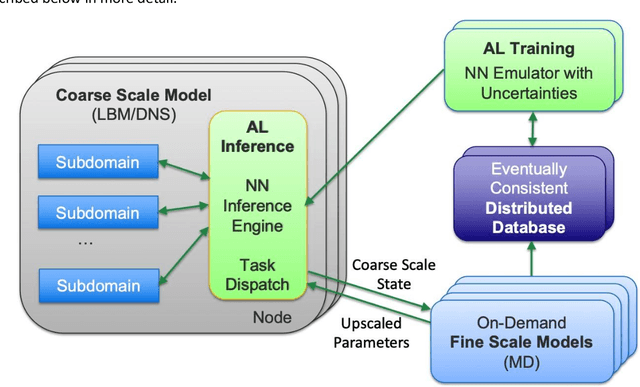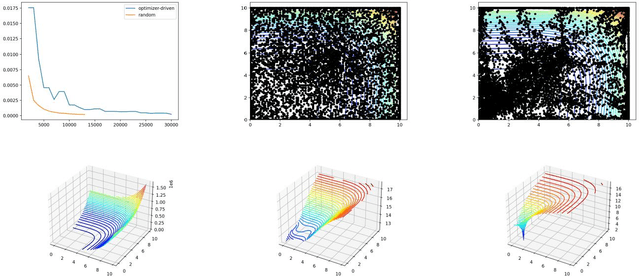Mohamed Mehana
Model-Agnostic Knowledge Guided Correction for Improved Neural Surrogate Rollout
Mar 13, 2025Abstract:Modeling the evolution of physical systems is critical to many applications in science and engineering. As the evolution of these systems is governed by partial differential equations (PDEs), there are a number of computational simulations which resolve these systems with high accuracy. However, as these simulations incur high computational costs, they are infeasible to be employed for large-scale analysis. A popular alternative to simulators are neural network surrogates which are trained in a data-driven manner and are much more computationally efficient. However, these surrogate models suffer from high rollout error when used autoregressively, especially when confronted with training data paucity. Existing work proposes to improve surrogate rollout error by either including physical loss terms directly in the optimization of the model or incorporating computational simulators as `differentiable layers' in the neural network. Both of these approaches have their challenges, with physical loss functions suffering from slow convergence for stiff PDEs and simulator layers requiring gradients which are not always available, especially in legacy simulators. We propose the Hybrid PDE Predictor with Reinforcement Learning (HyPER) model: a model-agnostic, RL based, cost-aware model which combines a neural surrogate, RL decision model, and a physics simulator (with or without gradients) to reduce surrogate rollout error significantly. In addition to reducing in-distribution rollout error by **47%-78%**, HyPER learns an intelligent policy that is adaptable to changing physical conditions and resistant to noise corruption. Code available at https://github.com/scailab/HyPER.
Enabling Clean Energy Resilience with Machine Learning-Empowered Underground Hydrogen Storage
Apr 04, 2024Abstract:To address the urgent challenge of climate change, there is a critical need to transition away from fossil fuels towards sustainable energy systems, with renewable energy sources playing a pivotal role. However, the inherent variability of renewable energy, without effective storage solutions, often leads to imbalances between energy supply and demand. Underground Hydrogen Storage (UHS) emerges as a promising long-term storage solution to bridge this gap, yet its widespread implementation is impeded by the high computational costs associated with high fidelity UHS simulations. This paper introduces UHS from a data-driven perspective and outlines a roadmap for integrating machine learning into UHS, thereby facilitating the large-scale deployment of UHS.
A Critical Review of Physics-Informed Machine Learning Applications in Subsurface Energy Systems
Aug 06, 2023Abstract:Machine learning has emerged as a powerful tool in various fields, including computer vision, natural language processing, and speech recognition. It can unravel hidden patterns within large data sets and reveal unparalleled insights, revolutionizing many industries and disciplines. However, machine and deep learning models lack interpretability and limited domain-specific knowledge, especially in applications such as physics and engineering. Alternatively, physics-informed machine learning (PIML) techniques integrate physics principles into data-driven models. By combining deep learning with domain knowledge, PIML improves the generalization of the model, abidance by the governing physical laws, and interpretability. This paper comprehensively reviews PIML applications related to subsurface energy systems, mainly in the oil and gas industry. The review highlights the successful utilization of PIML for tasks such as seismic applications, reservoir simulation, hydrocarbons production forecasting, and intelligent decision-making in the exploration and production stages. Additionally, it demonstrates PIML's capabilities to revolutionize the oil and gas industry and other emerging areas of interest, such as carbon and hydrogen storage; and geothermal systems by providing more accurate and reliable predictions for resource management and operational efficiency.
Predictive Scale-Bridging Simulations through Active Learning
Sep 20, 2022


Abstract:Throughout computational science, there is a growing need to utilize the continual improvements in raw computational horsepower to achieve greater physical fidelity through scale-bridging over brute-force increases in the number of mesh elements. For instance, quantitative predictions of transport in nanoporous media, critical to hydrocarbon extraction from tight shale formations, are impossible without accounting for molecular-level interactions. Similarly, inertial confinement fusion simulations rely on numerical diffusion to simulate molecular effects such as non-local transport and mixing without truly accounting for molecular interactions. With these two disparate applications in mind, we develop a novel capability which uses an active learning approach to optimize the use of local fine-scale simulations for informing coarse-scale hydrodynamics. Our approach addresses three challenges: forecasting continuum coarse-scale trajectory to speculatively execute new fine-scale molecular dynamics calculations, dynamically updating coarse-scale from fine-scale calculations, and quantifying uncertainty in neural network models.
 Add to Chrome
Add to Chrome Add to Firefox
Add to Firefox Add to Edge
Add to Edge